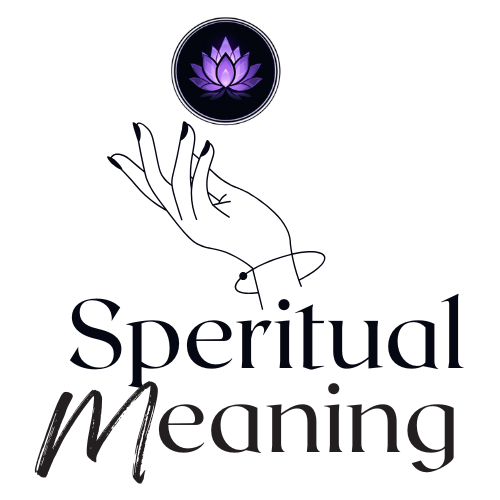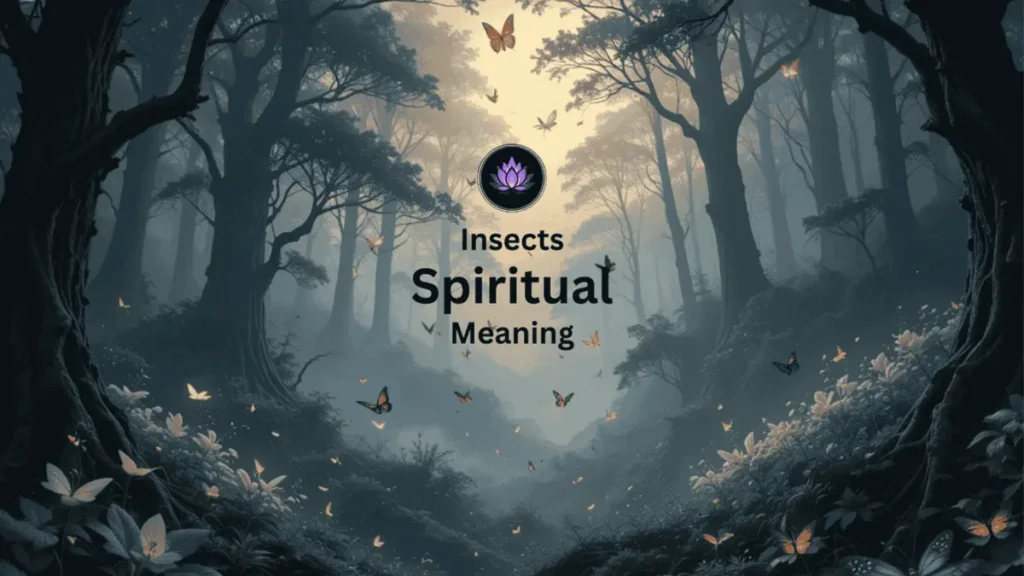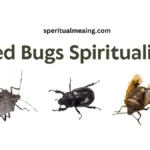Throughout history, insects have held profound symbolic meanings in human culture and spirituality. Their unique life cycles, behaviors, and remarkable adaptability have made them powerful symbols of transformation, resilience, and inner wisdom. In almost every culture and belief system, insects have been seen as messengers, guides, and symbols of spiritual truth.
Their constant presence in daily life, from gardens to dreams, has long prompted people to see deeper meanings in their appearance. Beyond being part of nature’s ecosystem, insects often carry messages about change, persistence, community, and the hidden forces at work in our lives. This article will explore spiritual Meaning of Insects, how different traditions and spiritual systems interpret the symbolism of insects, offering insights into what these small creatures might mean when they appear in our surroundings, dreams, or rituals.
Symbolic and Spiritual Meanings (General):
Here are the explanations for what do insects symbolize
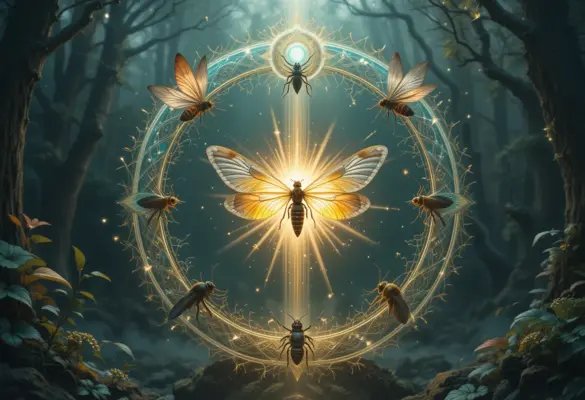
Transformation and Metamorphosis:
One of the most universal spiritual meanings associated with insects is the idea of transformation. Creatures like butterflies and moths undergo remarkable changes during their lifetimes. They start as eggs, become crawling caterpillars, then enter a cocoon, and finally emerge as winged beings. This dramatic process mirrors the human journey of growth, rebirth, and spiritual awakening.
In many cultures, this metamorphosis is a symbol of hope and the soul’s progress through different stages of life. Emerging from a cocoon is often compared to stepping into a new chapter or achieving enlightenment after a period of difficulty. When insects like butterflies appear in one’s life, they might symbolize that it’s time for personal renewal and positive change.
Survival and Adaptability:
Insects are incredibly resilient and can thrive in a wide range of environments. This resilience has made them symbols of survival, persistence, and adaptability. For example, cockroaches are famously hard to eliminate and can endure even harsh conditions. Spiritually, such creatures remind us of the importance of enduring through life’s trials and continuing to move forward, even in the face of adversity.
Community and Cooperation:
Social insects like ants, bees, and termites live in structured communities where every member plays a specific role. They represent values like teamwork, cooperation, and collective strength. Spiritual teachings often use these insects to remind people of the importance of working together for the common good. Seeing ants or bees might be interpreted as a call to build connections, stay diligent, and contribute to a larger purpose.
Psychological Interpretations:
In psychological symbolism, insects can also reflect aspects of the human mind. Insects appearing in dreams or visions might symbolize small anxieties or nagging worries that persist in the background of our thoughts. Because insects are small but numerous, they can also represent how many small, consistent efforts can lead to significant change, much like how great goals are achieved gradually through persistent work.
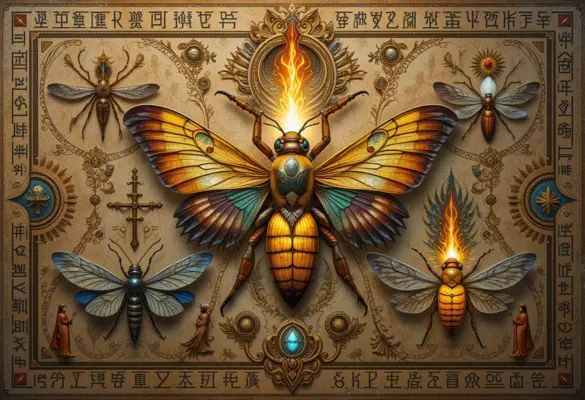
Symbolism of Specific Insects:
Flies:
Flies typically carry negative connotations in spiritual symbolism. As creatures associated with decay and waste, they are often seen as symbols of impurity, corruption, or death. In religious traditions, flies have been viewed as representations of sin or destructive forces. However, their persistent nature can also serve as a reminder to address lingering negative habits or outdated beliefs before meaningful progress can be made.
Butterflies and Moths:
Butterflies are among the most cherished symbols of change, freedom, and beauty. In spiritual teachings, they represent resurrection, new beginnings, and the soul’s journey toward enlightenment. Many Native American traditions view butterflies as messengers of hope and symbols of rebirth. Moths, their nocturnal cousins, symbolize spiritual searching and the attraction to higher truths. A moth drawn to light reflects the soul’s yearning for wisdom but also serves as a caution against chasing superficial or harmful desires.
Ants:
Ants embody qualities such as diligence, patience, and communal cooperation. They are praised in religious texts for their industriousness and ability to plan ahead. Spiritually, ants remind us to stay organized, work with others, and approach long-term goals with steady, humble effort. If ants enter your home or appear repeatedly, it may suggest the need for careful planning and collaboration in your life.
Bees:
Bees symbolize community, productivity, and the rewards of labor. They pollinate plants, supporting life and creation. In spiritual teachings, bees are often associated with fertility, abundance, and the sweetness of life’s hard-earned fruits. A bee entering your life might be a reminder to focus on goals, foster connections, or enjoy the positive outcomes of your persistence.
Ladybugs:
Ladybugs are widely seen as symbols of good luck, protection, and blessings. In many folk traditions, making a wish when a ladybug lands on you is believed to invite good fortune. These gentle creatures often symbolize divine favor and the arrival of positive changes.
Dragonflies:
Dragonflies are symbols of transformation, clarity, and emotional depth. With a life cycle that moves from water (representing the subconscious) to air (the conscious mind), dragonflies embody the blending of inner emotions with outward awareness. Seeing a dragonfly can signal a time to reflect, adapt, and embrace clarity in your life.
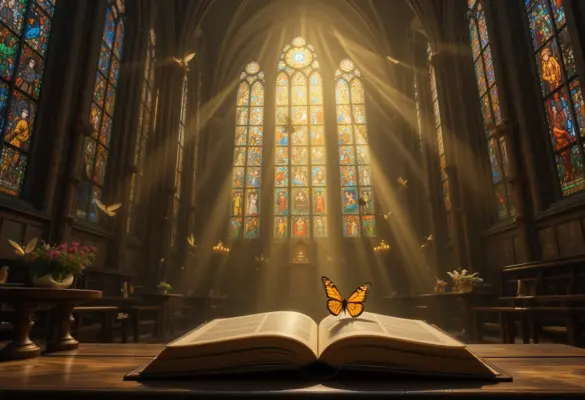
Spiritual Meaning of Insects: Cultural and Religious Interpretations
Christianity:
In Christian symbolism, insects appear in stories of divine judgment and spiritual lessons. The plagues of Egypt, including swarms of flies and locusts, represented purification and divine power. Butterflies symbolize resurrection and new life, while bees have occasionally symbolized community and Christ’s sweetness. Insect encounters in this tradition may prompt reflection on one’s spiritual state and relationship with God.

Islam:
In Islam, insects like ants appear in sacred texts, symbolizing humility and divine communication. Dream interpretations often assign meanings to insect encounters, with small bugs representing minor enemies or troubles. Islamic teachings stress compassion for all creatures while permitting the removal of harmful pests, emphasizing balance between mercy and practicality.

Hinduism:
In Hindu mythology, insects play varied roles. The goddess Bhramari Devi is linked to bees, symbolizing protective power against negativity. Ants represent diligence, and reincarnation beliefs encompass all life forms, including insects. In dream interpretations, insects often signal illness or betrayal. Hindu teachings advocate for kindness to all beings, recognizing insects as part of the cosmic order.
Buddhism:
Buddhism views insects as sentient beings subject to karma and rebirth. Insects symbolize impermanence and the interconnectedness of life. Buddhist stories often feature insects as examples of patience and humility. Encounters with insects can serve as reminders of life’s fragile nature and the importance of compassion for all creatures.
Native American Traditions:
In Native American beliefs, insects like butterflies and dragonflies are seen as spirit messengers. They symbolize joy, change, and the cycle of life. Butterflies are believed to carry wishes and prayers to the Great Spirit. Ants symbolize community strength and cooperation. Insects are generally honored as teachers of humility, patience, and balance.
Ancient Egypt:
Ancient Egyptians revered insects like the scarab beetle, associating it with rebirth and the sun’s daily journey. Scarab amulets were buried with the dead as symbols of protection and eternal life. Bees and flies also appeared in royal symbolism, reflecting authority and divine power.

Encountering Insects in Daily Life:
In Your Home or Around You:
Across many spiritual beliefs, insects appearing in the home carry messages about our environment and inner world. For instance, seeing ants marching indoors might be a subtle reminder about the importance of hard work, discipline, or addressing disorganization. A ladybug inside a house is often taken as a sign of good fortune and positive energy. Some spiritual traditions suggest that a sudden swarm or noticeable number of insects might indicate it’s time to cleanse your surroundings of negative patterns and stale energies.
Insects at Night:
When insects appear at night, especially in one’s bedroom, their symbolism can become more personal and mysterious. Nocturnal insects like moths are often linked to hidden fears or intuitive insights. A moth drawn to a lamp in the dark is sometimes seen as a symbol of the soul seeking truth and clarity amidst confusion. In folk beliefs, nocturnal insects such as crickets can symbolize protective spirits or guardians watching over a household.
Insects Flying or Landing on You:
When insects hover around or land on a person, it can carry symbolic significance. A butterfly or dragonfly fluttering nearby is often interpreted as a sign that transformation or emotional clarity is on the horizon. If an insect lands on you — for example, a butterfly resting on your hand — many spiritual teachings see this as a direct personal message, perhaps signaling a spiritual blessing or an affirmation to remain reflective and patient.
Cockroaches:
Despite their negative reputation, cockroaches hold powerful spiritual symbolism. Their remarkable ability to survive through history makes them symbols of resilience and adaptability. Encountering a cockroach in dreams or life can suggest that you possess the strength to overcome adversity, while also reminding you to confront and clear out undesirable habits or situations.
Interpretations of Insect Encounters:
Insects in Your House:
When insects enter a house, different traditions assign various meanings. Ants in the kitchen might symbolize the need to secure resources and maintain order. A butterfly indoors could indicate personal transformation or positive changes within the family. Unwanted pests, like flies or cockroaches, might be viewed as signs to cleanse one’s living environment or clear away mental and emotional clutter.
Flying Insects Around You:
Insects flying around you may symbolize fleeting thoughts, ideas, or intuitive messages. Butterflies and dragonflies might urge you to embrace change or go with the flow of life’s events. Busy bees suggest imminent social gatherings or work-related tasks. Flies buzzing around might indicate unaddressed anxieties or areas in life that need attention.
Insects Landing on You:
Many cultures believe that when an insect lands on you, it brings a personal message or blessing. A butterfly landing on your hand might affirm that you’re progressing on your spiritual path. An ant might serve as a reminder to stay humble and hardworking. A fly or cockroach might suggest the presence of lingering issues that need resolution.

Insects in Dreams (Major Traditions)
Dreams have long been regarded as windows into the subconscious, revealing unspoken emotions, hidden desires, and spiritual messages. Across cultures and spiritual traditions, insects appearing in dreams are seen as significant symbols, often reflecting personal transformation, suppressed worries, or divine communication. The specific insect and the nature of its appearance can influence the interpretation, offering valuable insights into one’s waking life.
Christian and Biblical Dream Symbolism:
In Christian dream interpretation, insects such as locusts and flies often signify decay, sin, or spiritual challenges. Biblical references, like the plagues in Exodus, associate swarms of insects with divine punishment and moral lessons. However, more positive interpretations exist as well. Dreaming of a butterfly is sometimes seen as a sign of resurrection or spiritual renewal, symbolizing the soul’s journey through death and rebirth.
Islamic Dream Interpretation:
Islamic teachings place significant importance on the symbolism of dreams. Insects appearing in dreams are typically interpreted through their behavior and size. Small insects, like ants or flies, might represent minor worries or enemies, while larger or swarming insects could signify more pressing personal or social issues. A bee in a dream, however, is often viewed favorably, symbolizing productivity, knowledge, and divine guidance. Islamic scholars have historically compiled dream dictionaries detailing the meanings of various insects, guiding believers in understanding their subconscious messages.
Hindu Dream Symbolism:
In Hinduism, dreams are considered a reflection of karma, inner thoughts, and future omens. Insects appearing in dreams might carry both auspicious and inauspicious meanings depending on their type and actions. Ants or bees moving methodically could signify forthcoming wealth or the need for patience and diligence. Conversely, dreams of being bitten by insects might indicate betrayal, illness, or unresolved emotional issues. Butterflies appearing in dreams are seen as positive omens, representing change, spiritual growth, and liberation from old attachments.
Buddhist Dream Interpretations:
Buddhism regards dreams as opportunities for insight into the impermanent and interconnected nature of existence. Insects in dreams can symbolize small attachments or minor irritations that disrupt inner peace. However, the specific insect often dictates the lesson. A dream of a dragonfly, for instance, might suggest the need to embrace change and fluidity, while a moth drawn to a flame could represent the dangers of clinging to desires that ultimately cause suffering. Insects in Buddhist dream interpretation generally urge reflection on the small but persistent factors affecting one’s spiritual journey.
Native American Dream Lore:
Many Native American tribes hold that dreams are messages from the spirit world. Insects appearing in dreams often carry messages from ancestors or nature spirits. A butterfly in a dream might be a sign of personal transformation, signaling that a change in life path or personal identity is near. Ants symbolize community responsibilities, while dragonflies might represent wisdom from the spirit realm or guidance in times of emotional turbulence. Dreaming of bees could suggest the arrival of good news or a reminder to stay connected with one’s community.
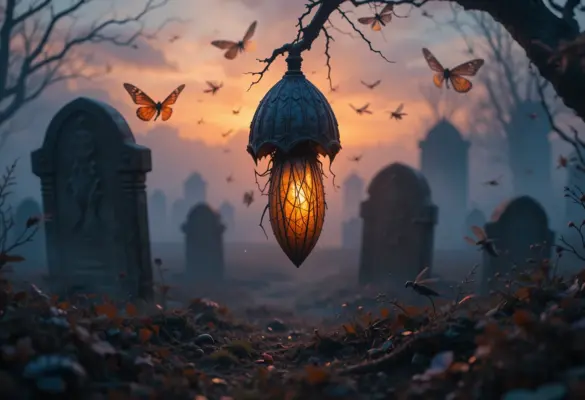
Insects as Symbols of Death and Transformation:
Insects have long been associated with the mysteries of death and the promise of transformation in the afterlife. Their life cycles, especially those involving metamorphosis, mirror the human experience of birth, death, and spiritual rebirth. Different cultures and spiritual systems have embraced this symbolism, viewing insects as both harbingers of endings and guides to new beginnings. here is explanation for what insect symbolizes death.
Butterflies: Messengers of the Departed;
Among the most widely recognized insect symbols of death and transformation is the butterfly. In countless traditions, butterflies are believed to carry the souls of the departed to the afterlife. Their transformation from caterpillar to chrysalis to winged beauty serves as a metaphor for the soul’s liberation from the physical body. In some Native American and Celtic beliefs, a butterfly fluttering nearby is thought to be the spirit of a loved one offering comfort or a final message.
Moths: Symbols of the Soul’s Journey:
Moths, with their nocturnal nature and attraction to light, have often been linked to the mysteries of death and the soul’s search for truth beyond the mortal world. In ancient folklore, a moth’s appearance at night was seen as a sign that a spirit was present or that a message from the other side was imminent. Their symbolism extends to the idea of being drawn to one’s destiny, even when it involves crossing into the unknown.
Scarab Beetles in Ancient Egypt:
In ancient Egyptian spiritual practice, the scarab beetle represented immortality and resurrection. The dung beetle, which rolls spheres of earth, was likened to the sun’s journey across the sky. Scarabs were placed in tombs and worn as amulets to ensure safe passage into the afterlife. The symbolism reflected the idea that life continues after death, with the soul reborn in a new, transformed state.
Flies: Omens of Decay and Transition:
In contrast, flies have traditionally symbolized decay, corruption, and the inevitability of death. Their appearance around carrion or in places of decay reinforced their association with endings and the breakdown of the old. In spiritual interpretations, flies can serve as reminders of the temporary nature of material life and the importance of spiritual purification before passing into the next stage of existence.
Bees: Guardians of the Threshold:
In ancient European folklore, bees were regarded as sacred intermediaries between the living and the dead. There was a custom known as “telling the bees,” in which family members would inform beehives of a death in the household, believing that bees could carry the soul’s message to the other world. Bees symbolized the continuation of life’s cycles, the preservation of memory, and the connection between earthly life and the spirit world.
Ants and Termites: Death, Renewal, and Ancestral Spirits:
In some African spiritual systems, ants and termites are associated with ancestors and the earth’s regenerative powers. Termite mounds were sometimes seen as sacred sites, representing the connection between the living and the dead. The activity of these insects within the soil symbolized the constant renewal of life and the return of the physical body to the earth, while the spirit moves on to join ancestral forces.
Conclusion:
Insects have fascinated and inspired spiritual thought for thousands of years. Their varied behaviors, life cycles, and resilience have made them enduring symbols of transformation, death, renewal, and community let people even in this modern time think for insect spiritual meaning. Whether appearing in homes, dreams, or ancient myths, insects communicate powerful spiritual messages about the hidden forces shaping human experience.
From the butterfly’s graceful metamorphosis to the scarab’s ancient symbolism of resurrection, insects invite us to reflect on the cycles of life, the importance of patience and persistence, and the need to adapt to life’s many changes. Across Christian, Islamic, Hindu, Buddhist, Native American, and ancient Egyptian traditions, insects remind us that the smallest creatures can carry the greatest wisdom.
By paying attention to the appearance of insects in our environment and the symbolism attributed to them in different spiritual systems, we gain deeper insight into our own lives, our subconscious, and the world beyond the visible. These tiny creatures are far more than incidental parts of nature — they are living emblems of life’s mysteries and the spiritual journey each of us must undertake.
